Podcast: Play in new window | Download (Duration: 19:41 — 27.6MB)
Subscribe: Apple Podcasts | Spotify | Amazon Music | Android | Pandora | iHeartRadio | JioSaavn | Podcast Index | Email | TuneIn | RSS | More
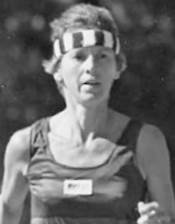 Sandra “Sandy” Jean (Mackey) Kiddy (1936-2018) of Rancho Mirage, California was the first woman to be inducted into the American Ultrarunning Hall of Fame. She paved the way for women in ultrarunning setting many of the early world and American ultrarunning records. She was born in Grand Rapids Michigan to Robert B. Mackey (1909-1983) and Marjorie Rosita Montez (1911-1993), Her father’s ancestry was from Ireland, and her mother’s ancestry was from Mexico.
Sandra “Sandy” Jean (Mackey) Kiddy (1936-2018) of Rancho Mirage, California was the first woman to be inducted into the American Ultrarunning Hall of Fame. She paved the way for women in ultrarunning setting many of the early world and American ultrarunning records. She was born in Grand Rapids Michigan to Robert B. Mackey (1909-1983) and Marjorie Rosita Montez (1911-1993), Her father’s ancestry was from Ireland, and her mother’s ancestry was from Mexico.
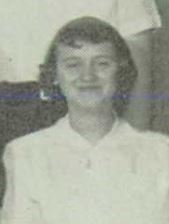

In 1962, she married Frederick “Fred” Kiddy, born in Sheffield, England, who became a bank manager. They married in Las Vegas, Nevada, while driving across the country to California. Once in Los Angeles, Sandy worked first at Caltech and then for Microbics at Beckman Instruments, where she patented a number of reagent laboratory tests.
| Learn about the rich and long history of ultrarunning. There are now eleven books available in the Ultrarunning History series on Amazon Learn More |
Early Running
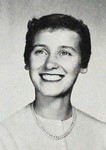

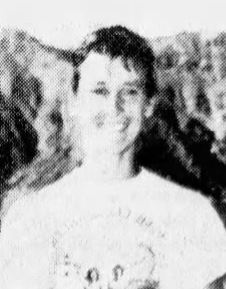

Eventually, her group got her interested in road racing. Her first race was in 1976 at the age of 40. She ran a couple short races where she broke course records. She next tackled the marathon because the shorter races seemed like a sprint. In her race registrations, she went by “Sandra” because people kept mistaking her name, “Sandy” as belonging to a man. “Three months after that first long run, I tried a marathon. I broke 3:30, which was quite thrilling. I found I didn’t like the shorter races much, too much like a sprint, so we stuck primarily to the marathons, doing five or six a year.”
Kiddy almost always won among the runners age 40 and over, even including the men. In March 1978, she and Fred wrote into their local newspaper about a 10K with 700 runners that ran down Main Street in Palm Springs. “That your paper gave this event no coverage whatsoever is unforgivable and prompts the question as to what you consider newsworthy. May the curse of Pheidippides be on your circulation.”
Marathon Domination
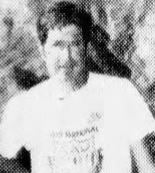

Kiddy started running multiple marathons a year. Her first of many wins came in 1978 at Lompro Record-Valley of Flowers Marathon with 3:02:36, running with Fred. She and Fred trained together and frequently ran together in the races. In 1978, she won the National Masters Marathon with 2:56:45. Fred finished in 2:47. In 1979, she won the Orange County Marathon in 2:58, a new course record. She said, “The course went along a bike path along the Santa Ana River. There were 20-plus bridges you had to go up and under. I was in pretty good shape, but the bridges took their toll.” In June 1979, Sandy got her picture in Sports Illustrated, in Faces in the Crowd.
Not only was she winning marathons, but her competitive nature was also in the cards. Her name was in the newspaper many times doing well in Bridge tournaments.
First Ultra
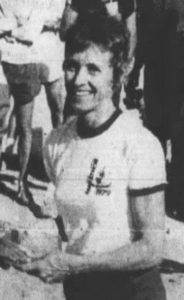

Kiddy at age 42, burst on the scene of ultras when she ran in the Southern Pacific AAU 50K at Camarillo, California in 1979. She won and set a world record of 3:37:08, beating the current record by three minutes. It was also Fred’s first ultra and he finished ahead of her. He frequently also won his master’s divisions. Kiddy repeated in 1980, lowering her record to 3:36:50. Of the 50K distance, Kiddy said, “That distance is just a long marathon, but yet it actually felt easier than a marathon for me. Because I feel I don’t ave very much speed, I put pressure on myself when I run a marathon or a shorter distance, pressure which I don’t feel when I run anything longer.”
Throughout her ultra career, Kiddy continued to race marathons. She said, “After I began running farther than the marathon, I would use races for speed work. I have done speed work on the track, but I preferred races where refreshments were available and the excitement of the race made me work harder.” She was very fast at shorter distances. She won the 1979 Desert Hot Springs 10K with 39:20.
Fighting Against TAC
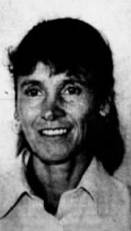

50-Milers


In 1981, Kiddy ran her first 50 miler, in 6:24, for a masters world record, and she lowered her time the next year to 6:15:47. She still ranks high on the all-time 50-mile list of the top of the American women’s performances. Of those early 50-mile races, she said, “I thought that the 6:12 record was in reach, but I ended up with 6:24 on my first try. So I lengthened my training runs, thinking that would put 6:12 easily within my grasp. But in my second try, I didn’t run a smart race. Every time I stopped for something to drink, I stopped completely, instead of a least walking. Now, I wear a straw around my neck so I don’t have to stop at all.”
In 1982, she ran what was her marathon best time of 2:53:23 at the San Francisco Marathon, setting an American age group record. She won the Yakima Valley 50 in Washington with 6:15, coming just three minutes short of Sue Ellen Trapp’s recent American Record. But her time was a world masters record. Kiddy, Sue Ellen Trapp, Donna Hudson, and Marcy Schwam kept taking turns with various ultra records, although they weren’t racing head-to-head. Kiddy eventually brought her 50-mile time down to 6:09:09. She would train between 80 to 95 miles per week.
The 100 km


The 100-Miler


Next up, she wanted to tackle the 100-miler. Why? She said, “Because I knew I could go more slowly.” Her longest training run up to this point had been 26 miles. So in 1983, she went to a special women’s invitational World Cup 100 Mile event in Germany with 22 runners. The race started at midnight. She battled with tough competition, including Monika Kuno of West Germany, who led for the first 50 miles. At mile 40 Kiddy decided she wasn’t going to worry about who was leading, so much could happen in that next 60 miles. At the 100K mark, Kiddy had a 21-second lead. It was close through mile 94, but Kiddy pulled away for the win with a time of 15:40:50, claiming the 100-mile world record beating, Marcy Schwam’s best by three minutes.
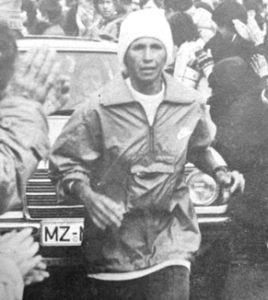

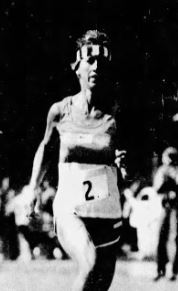

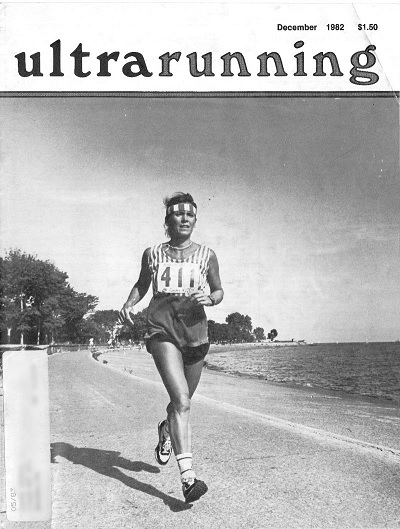

In 1984 Kiddy ran in the Wolfpack 50-Mile race at Columbus, Ohio, and road course with four-mile loops. She said, “The course itself was fairly difficult for me, thanks to a short, steep hill which was only a 15-20-foot rise, but which we had to go over 24 times. It took a toll on my legs.” But at age 47 she set a Masters World Record of 6:09:09. In August 1984, Sandy and Fred went to Scotland to run the classic Two Bridges 36-miler. Sandy won in 4:19:39, setting a new course record.
Overall 100K Winner
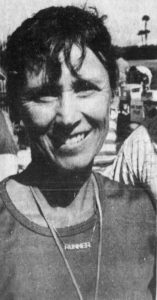

In October 1984, Kiddy ran the Edmund Fitzgerald 100K at Duluth, Minnesota. She said, “It was the perfect race for me. I soundly smashed 8 hours. The weather was cool and the course was rolling. None of the hills were so steep as to slow a runner’s pace sharply, and the down sides were gentle enough that you didn’t go out of control or have to break your stride. It was the first ultra in which I didn’t have any mental or physical depression, the kind of race every runner hopes for.” As she approached the finish, the lone runner ahead of her, Harry Sloan, was struggling mightily. Kiddy explained, “I needed a Coke, but there wasn’t any nearby. My handler went looking for some. Unbeknownst to him, or anyone else, he mistakenly took the Coke that was set aside by Sloan’s handler. I drank the last bit of Coke available and then passed the leader with only about 100 yards to go.” She was the overall winner with 7:49:16, a world masters record and the fastest women’s 100K ever run on American soil at that time.
Running in Europe
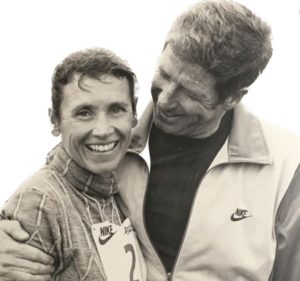

With her 100k win, she was put on the USA 100K team and was able to compete in the 100K in Belgium, and later in Spain. Dan Brannen wrote, “In 1985 and 1986 Kiddy set Europe ablaze, winning London-to-Brighton and the Winschoten and Torhout 100kms, each of the latter two in just over 8 hours. She was right on the cutting edge of the high-profile European 100km phenomenon which would bring media attention, prize money, and national team competition to these events. Continental Europe led the way in this breakthrough, and this American woman in her late 40’s was their queen. At the end of 1986, just a week shy of her 50th birthday, she ran 7:56:21 to win the Philadelphia-to-Atlantic City 100km. Of the half-dozen 100km races Kiddy ran in her prime, all of them were major events, she was undefeated, and her average time was under 8 hours.”
100 Mile American Record Again
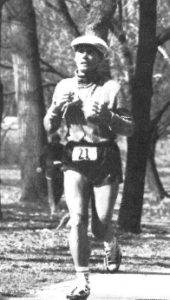

Running on Trails
Kiddy tested her speed at a popular trail race, the 1986 Ice Age 50 in Wisconsin, and won. However, she preferred running on roads. She said, “I never felt comfortable running on the trails. When I run, I’m not concentrating on the surface.” In 1986, both Kiddy and Fred won the Palm Springs Marathon.
In 1987, Kiddy was named to the newly-formed Ultrarunning Subcommittee of TAC/USA (later renamed USA Track & Field). She was instrumental in setting policies and standards for the selection of USA national championships and teams for the next ten years.
Ultrarunning of the Year
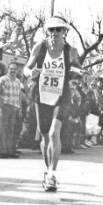

Kiddy was named “Ultrarunner of the Year” twice, for 1986 and 1987. Reflecting on her running accomplishments, she said, “Most aspects of my life have been fairly average, but in ultramarathoning I’ve found something I can really do well.” In her early 50s, she struggled with a persistent hamstring injury and backed off her racing. In 1990, at age 53, she had the honor of running in “The Greatest 100K Road Race in History,” at the World 100K Championship held in the United States at Duluth, Minnesota. She ran in 9:23, finishing in 13th.
For her last hurrah running ultras, she went out in style by being the oldest athlete to ever be on a USA national team. She competed in the 1992 World 100K Championship in Spain. At age 55, she finished in 8:42 setting a world age-group record.
After Competitive Running


In 2002, Kiddy was inducted into the USA Track and Field Masters Hall of Fame. In 2004, she was the first woman to be inducted into the American Ultrarunning Hall of Fame. During her career, she held 16 American and world records at one time or another. Some of her master’s records still stand. Norman Klein, the former race director for the Western States 100 said, “She was one of the first great ones. Even today, she would be in the top five, if not the top three. If Ann Trason and Sandra Kiddy were of the same age and running the same road race, I would love to see it. That would really be a show to watch.”
What happened to all her medals and trophies? She explained, “We don’t even have those medals or trophies any more. That is not what it was all about. Both Fred and I gave them to local schools many years ago, because recognition means much, much more to children. We have the memories and that is satisfaction enough.” After not running an ultra for ten years, in 2003, at age 66, she was asked if she would ever run one again. “No. I do miss the camaraderie of spending time together after a race, but I never even think of going back out there. The thing is, I wouldn’t want to run any race but an ultra, and I know my training is not good enough for me to perform the way I would like. I’m still running nine or ten miles per day, when I don’t play golf. My fastest mile now was 8:27.”
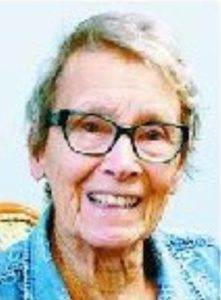

In 2005, at 68, Kiddy estimated that she had run about 75 ultras and finished them all, with no DNFs. She no longer raced but still ran about 65 miles each week. Her husband and running partner for years, Fred, passed away in 2006. In 2012, Kiddy was winning playing Bridge in Reading, Pennsylvania. In 2018, Sandy Kiddy passed away in West Reading, Pennsylvania, at the age of 81.
Sources:
- The Desert Sun (Palm Springs, California), Dec 20, 1976, Jun 2, Dec 16, 24, 28, 1978, Apr 9, May 1, 1979, Dec 4, 24, 1979, Dec 1, 1981, Jun 14, 2006
- The Lompoc Record (California), Jun 25, 1978, May 18, Jun 15, 26, 1979
- The Daily Breeze (Torrance, California), Jul 24, 1977
- Palm Desert Post (California), Dec 28, 1978
- The Tustin News (California), Mar 15, Apr 19, 1979
- Camarillo Star (California), Apr 29, 1980
- The Daily Breeze (Torrance, California), Jun 14, 1981
- Ultrarunning Magazine, Oct 1983, Apr 2003
- Nick Marshall, Ultra Distance Summary
- Sandra Kiddy Obituary

